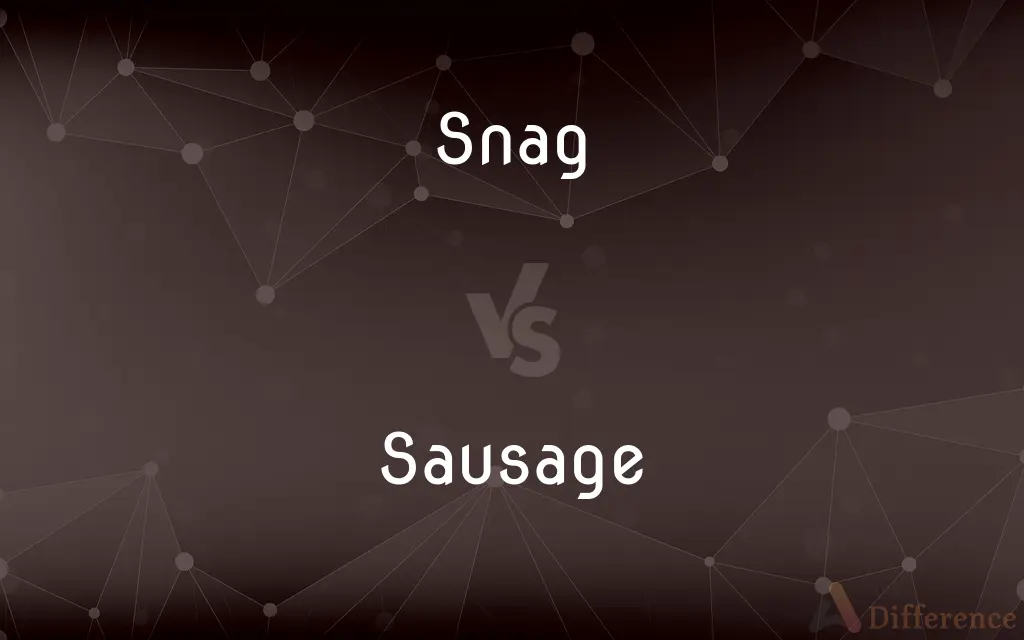Snag vs. Sausage — What's the Difference?
By Fiza Rafique & Maham Liaqat — Updated on April 16, 2024
Snag refers to a sudden or unexpected problem, while sausage is a type of seasoned meat encased in a skin, commonly eaten as part of various cuisines.

Difference Between Snag and Sausage
Table of Contents
ADVERTISEMENT
Key Differences
Snag is commonly used to describe a complication or hitch in a plan or process, suggesting an obstacle that needs to be overcome. On the other hand, sausage represents a food item made from ground meat, spices, and other flavorings, encased in a skin or casing.
While a snag typically appears in contexts involving tasks, projects, or processes, highlighting an unforeseen difficulty that interrupts progress, sausage is discussed in culinary contexts, often highlighting its varieties and uses in different dishes.
In practical usage, when someone encounters a snag, it implies the need for problem-solving or adjustments to achieve a desired outcome. Conversely, sausage is used in various dishes and can be cooked in multiple ways, such as grilling, frying, or baking.
Snag also has a broader metaphorical application, used to express any form of interruption or problem in everyday life or in narratives. In contrast, sausage is a staple in many diets around the world and is a key component in traditional meals in cultures such as German, Italian, and Polish.
While snag often carries a negative connotation, as it represents problems or obstacles, sausage tends to have a neutral or positive connotation, associated with food, comfort, and culture.
ADVERTISEMENT
Comparison Chart
Definition
A sudden or unexpected obstacle or issue
A food product made of ground meat and spices
Context
Problems in plans or processes
Culinary, especially in meat preparation
Connotation
Negative (problems, issues)
Generally positive (food, variety)
Metaphorical Use
Common (any small problem)
Rare
Varieties
N/A
Numerous (e.g., Italian, chorizo, bratwurst)
Compare with Definitions
Snag
A sudden obstacle.
The project hit a snag when funding was unexpectedly cut.
Sausage
Can be made from various meats.
You can find sausage made from pork, beef, or even turkey.
Snag
A sharp, angular part sticking out.
Be careful of the snag on that broken chair.
Sausage
Cooked by several methods.
She prefers her sausage baked instead of fried.
Snag
A submerged tree or branch that can impede navigation.
The boat slowed down to avoid the snag in the river.
Sausage
Eaten worldwide in various forms.
In Germany, sausage is a key part of their diet.
Snag
A minor difficulty or disadvantage.
The only snag with the plan is that it requires more time than we have.
Sausage
Typically seasoned with spices.
This sausage has a mix of herbs and garlic.
Snag
A tear or break in fabric.
My sweater got a snag on the sharp fence.
Sausage
A meat product encased in skin.
We grilled sausages for the picnic.
Snag
A dead or partly dead tree that is still standing.
Sausage
A sausage is a type of meat product usually made from ground meat, often pork, beef, or poultry, along with salt, spices and other flavourings. Other ingredients such as grains or breadcrumbs may be included as fillers or extenders.
Snag
A tree or a part of a tree that is sunken in or protrudes above a body of water and is a danger to navigation.
Sausage
An item of food in the form of a cylindrical length of minced pork or other meat encased in a skin, typically sold raw to be grilled or fried before eating.
Snag
A snaggletooth.
Sausage
Used as an affectionate form of address, especially to a child
‘Silly sausage,’ he teased
Snag
A short or imperfectly developed branch of a deer's antler.
Sausage
Finely chopped and seasoned meat, especially pork, usually stuffed into a prepared animal intestine or other casing and cooked or cured.
Snag
A break, pull, or tear in fabric.
Sausage
A small cylinder-shaped serving of this meat.
Snag
An unforeseen or hidden obstacle or difficulty
Our plans for the party have hit a snag.
Sausage
A food made of ground meat (or meat substitute) and seasoning, packed in a section of the animal's intestine, or in a similarly cylindrical shaped synthetic casing; a length of this food.
Snag
To tear, break, hinder, or destroy by or as if by a snag
Snagged a stocking on a splinter.
Sausage
A sausage-shaped thing.
Snag
(Informal) To catch or obtain quickly or unexpectedly
Snagged a ground ball.
Snagged a bargain.
Sausage
(informal) A term of endearment.
My little sausage
Snag
To free of snags
Snagged the river.
Sausage
A saucisse.
Snag
To catch (a fish), especially by hooking in a place other than its mouth.
Sausage
(engineering) To form a sausage-like shape, with a non-uniform cross section.
Snag
To be damaged by a snag
His sweater snagged on a tree branch.
Sausage
An article of food consisting of meat (esp. pork) minced and highly seasoned, and inclosed in a cylindrical case or skin usually made of the prepared intestine of some animal.
Snag
A stump or base of a branch that has been lopped off; a short branch, or a sharp or rough branch.
Sausage
A saucisson. See Saucisson.
Snag
A dead tree that remains standing.
Sausage
Highly seasoned minced meat stuffed in casings
Snag
A tree, or a branch of a tree, fixed in the bottom of a river or other navigable water, and rising nearly or quite to the surface, by which boats are sometimes pierced and sunk.
Sausage
A small nonrigid airship used for observation or as a barrage balloon
Snag
(by extension) Any sharp protuberant part of an object, which may catch, scratch, or tear other objects brought into contact with it.
Snag
A tooth projecting beyond the others; a broken or decayed tooth.
Snag
(figuratively) A problem or difficulty with something.
We hit a snag
Snag
A pulled thread or yarn, as in cloth.
Snag
One of the secondary branches of an antler.
Snag
A light meal.
Snag
A sausage.
Snag
A goal.
Snag
A misnaged, an opponent to Chassidic Judaism (more likely modern, for cultural reasons).
Snag
To catch or tear (e.g. fabric) upon a rough surface or projection.
Be careful not to snag your stockings on that concrete bench!
Snag
To damage or sink (a vessel) by collision; said of a tree or branch fixed to the bottom of a navigable body of water and partially submerged or rising to just beneath the surface.
The steamboat was snagged on the Mississippi River in 1862.
Snag
(fishing) To fish by means of dragging a large hook or hooks on a line, intending to impale the body (rather than the mouth) of the target.
We snagged for spoonbill from the eastern shore of the Mississippi River.
Snag
To obtain or pick up.
Ella snagged a bottle of water from the fridge before leaving for her jog.
Snag
To cut the snags or branches from, as the stem of a tree; to hew roughly.
Snag
A stump or base of a branch that has been lopped off; a short branch, or a sharp or rough branch; a knot; a protuberance.
The coat of armsNow on a naked snag in triumph borne.
Snag
A tooth projecting beyond the rest; contemptuously, a broken or decayed tooth.
Snag
A tree, or a branch of a tree, fixed in the bottom of a river or other navigable water, and rising nearly or quite to the surface, by which boats are sometimes pierced and sunk.
Snag
One of the secondary branches of an antler.
How thy snag teeth stand orderly,Like stakes which strut by the water side.
Snag
To cut the snags or branches from, as the stem of a tree; to hew roughly.
Snag
To injure or destroy, as a steamboat or other vessel, by a snag, or projecting part of a sunken tree.
Snag
A sharp protuberance
Snag
A dead tree that is still standing, usually in an undisturbed forest;
A snag can provide food and a habitat for insects and birds
Snag
An opening made forcibly as by pulling apart;
There was a rip in his pants
She had snags in her stockings
Snag
An unforeseen obstacle
Snag
Catch on a snag;
I snagged my stocking
Snag
Get by acting quickly and smartly;
Snag a bargain
Snag
Hew jaggedly
Common Curiosities
Are all sausages encased in natural skins?
No, some sausages use synthetic casings, while others may have no casing at all.
What are the health considerations with eating sausage?
Sausages often contain high levels of fat and sodium, so moderation is advised, especially for people with dietary restrictions.
What is the origin of the word "snag"?
"Snag" comes from Middle English, originally meaning a stump or a part of a tree sticking out from the water.
Can "snag" be used in formal writing?
Yes, "snag" is acceptable in formal contexts to describe unexpected difficulties or issues.
What differentiates fresh sausage from cured sausage?
Fresh sausage is made to be cooked and consumed relatively quickly, whereas cured sausage has been treated to preserve it for longer storage.
What spices are commonly found in sausages?
Spices like black pepper, garlic, fennel, and paprika are commonly used in various sausage recipes.
How can "snag" be used metaphorically?
Metaphorically, "snag" can describe any unexpected challenge or hitch in areas such as relationships, negotiations, or personal plans.
How is sausage typically prepared in different cultures?
In Italy, sausages are often grilled or used in pasta dishes, while in the U.S., they are popular as breakfast items or barbecued.
Can sausages be part of a healthy diet?
Yes, choosing leaner meats and lower-sodium options can make sausages a part of a balanced diet.
How does one typically resolve a snag?
Resolving a snag usually involves troubleshooting, making adjustments, or finding alternative solutions.
Does the term "snag" have any specific usage in industries?
In construction and software development, "snag" often refers to minor defects or issues that need addressing before a project is completed.
Is "snag" used internationally in English-speaking countries?
Yes, while "snag" is understood in many English-speaking regions, its usage and popularity might vary.
Are there any cultural events centered around sausages?
Yes, many cultures have festivals and events celebrating sausages, such as Germany's Oktoberfest and sausage festivals in various parts of the world.
What are common misconceptions about the term "snag"?
A common misconception is that a snag always represents a significant problem; however, it often refers to minor or manageable issues.
Share Your Discovery

Previous Comparison
Ecotype vs. Ecad
Next Comparison
Mazut vs. DieselAuthor Spotlight
Written by
Fiza RafiqueFiza Rafique is a skilled content writer at AskDifference.com, where she meticulously refines and enhances written pieces. Drawing from her vast editorial expertise, Fiza ensures clarity, accuracy, and precision in every article. Passionate about language, she continually seeks to elevate the quality of content for readers worldwide.
Co-written by
Maham Liaqat















































